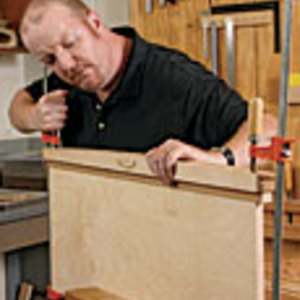Two Jigs That Help Sharpen a Skew Plane Blade
Learn how two easy jigs can help sharpen a skew plane blade
A skew rabbet block plane is a versatile tool. It works as a conventional block plane, but because the skew blade makes super-clean cross grain cuts, it’s the ideal plane for trimming tenon cheeks. That fact was confirmed in a recent tool test (The Best Planes for Fitting Tenons, FWW #231) by hand-tool expert and frequent FWW contributor Chris Gochnour.
The skewed blade may look tough to sharpen, but Gochnour says it’s not so. If you are skilled at freehand sharpening, it will take you a bit of practice to get the job done. The trick is not only to maintain a consistent bevel but also to avoid altering the original skew angle.
But if you don’t work freehand, there are two surefire methods to sharpening the blade that take all the guesswork out of the equation. Each starts with a Veritas honing guide (leevalley.com).
The Veritas Mk.II Honing Guide ($66.50) accepts an accessory jig specially made for sharpening skew blades. Called the Skew Registration Jig ($29.50), it attaches to the Mk.II and allows you to lock in the skew angle easily.
You also can use the honing guide from the Veritas Sharpening System ($46.50) and pair it with a shopmade stop block, dialed in to register the blade at the correct skew and bevel angle. This idea is similar to a system Fine Woodworking magazine featured in issue #213 (Get Sharp—Fast), where you use stop blocks. The stops, set a given distance to the edge of a board, help you load the blade into a honing guide so that you are sharpening at the desired bevel angle. To make the stop block, Gochnour first sets up the skew blade in the honing guide with the help of a digital angle gauge, which helps dial in the bevel angle. Then he cuts a rabbet in a scrap block that’s as wide as the blade projection from the guide. He labels the angle on the block and then uses it when he’s ready to hone the blade. It’s pretty easy to do.
With either of these setups, you’ll get your skew blade sharp consistently and easily, which means you’ll get back to work faster.
Skew Registration Jig
Setup is simple. After installing the Skew Registration Jig on the Mk.II honing guide, lock the pin and stop to the desired bevel and skew angles. Register the blade against the stop and lock it in place.

Hone away. Within seconds you’re honing the blade accurately and consistently.

Sharpening System and Stop Block
Set the blade against the stop. Place the tip of the skew blade flush against the stop and place the honing guide on the blade.

Lock in the setting. Slide the honing guide against the edge of the stop block and lock the blade in place.

Hone away. As with the Mk.II setup, you’ll be honing the blade accurately and consistently.









Log in or create an account to post a comment.
Sign up Log in